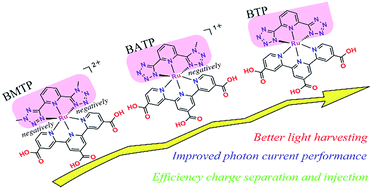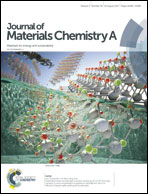Anionic ancillary ligands in cyclometalated Ru(ii) complex sensitizers improve photovoltaic efficiency of dye-sensitized solar cells: insights from theoretical investigations†
Abstract
We report a theoretical study concerning the impact of anionic ancillary ligands of Ru(II) complex dyes on the performance of dye-sensitized solar cells. We explicitly discuss three Ru(II) complex dyes with either neutral or anionic tetrazolyl-based ligands. Density functional theory and time-dependent density functional theory methods were used to determine the geometrical structures, electronic structures and absorption spectra of the sensitizers. We also conducted quantum dynamics simulation in order to elucidate how anionic ancillary ligands affect charge transfer at the dye/TiO2 interface. The calculation results suggest that the addition of more anionic ancillary ligands can efficiently raise the energy levels of occupied orbitals, enhance light-harvesting ability, and improve interface charge separation and injection. The differences in the performance associated with different number of anionic ligands can be ascribed to fundamental atomistic details. Overall, the simulation results agree with experiments, provide atomistic details of the dye–TiO2 system, and contribute to the understanding of anionic tetrazolyl-based ligand induced improvement in device performance, which is expected to provide valuable insights into the development of anionic ligand based Ru complex dyes for dye-sensitized solar cell application.



 Please wait while we load your content...
Please wait while we load your content...